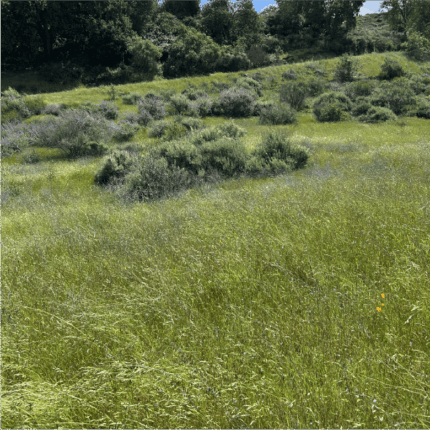If you raise cattle in Florida, choosing the right grass can make a huge difference in your herd’s health and your farm’s success. You want grass that grows well in Florida’s warm climate, stays nutritious, and keeps your cattle happy all year round.
But with so many options out there, how do you know which grass is truly the best for your land and livestock? You’ll discover the top grasses that thrive in Florida and boost your cattle’s growth and wellbeing. Keep reading to find out how to make your pasture work harder for you and your animals.

Credit: naturesseed.com
Climate Factors In Florida
Choosing the right grass for cattle in Florida depends a lot on the climate. Florida’s weather affects how grass grows and stays healthy. Understanding these climate factors helps farmers pick grasses that feed cattle well and last through the year.
Temperature And Rainfall Patterns
Florida has warm temperatures most of the year. Summers are hot and humid. Winters stay mild with little frost. Rainfall happens mostly in the summer months. This rain helps grass grow quickly in warm times. But dry spells can slow growth in winter. Grasses must handle heat and wet conditions well.
Soil Types And Quality
Florida soils vary from sandy to clay-like. Sandy soils drain water fast but hold fewer nutrients. Clay soils keep water longer but may cause root problems. Soil pH often leans acidic. Good grass needs soil with enough nutrients and proper pH. Testing soil helps farmers choose grasses that fit the land.
Seasonal Growth Considerations
Grass grows fastest in warm, wet seasons. In cool or dry months, growth slows down. Some grasses go dormant in winter. Others stay green and keep feeding cattle. Picking grass that grows year-round or recovers fast after dry periods is key. This keeps pastures healthy and cattle fed all year.

Credit: one-cow-revolution.com
Key Traits For Cattle Grass
Choosing the right grass for cattle in Florida needs careful thought. Cattle grass must meet key traits to support healthy animals and good farm results. These traits help grass survive Florida’s climate and provide enough food for cattle.
Nutritional Value
Good cattle grass offers high nutrition. It should have enough protein, fiber, and energy. These nutrients help cattle grow strong and stay healthy. Grass with poor nutrition makes cattle weak and slow.
Drought And Heat Tolerance
Florida can get hot and dry. Grass must survive heat and drought periods. Grass that handles stress stays green and grows well. It feeds cattle even in tough weather.
Growth Rate And Yield
Fast-growing grass gives more food in less time. High yield means more grass for cattle to eat. Grass that grows slow or produces little can cause food shortages.
Top Grass Varieties For Florida
Choosing the right grass for cattle in Florida is important. The climate is warm and often humid. Some grasses grow better in these conditions. The right grass helps cattle get good food all year. Here are some top grass types that work well in Florida.
Bahiagrass
Bahiagrass is tough and grows well in sandy soil. It survives dry times and needs little care. This grass provides good nutrition for cattle. It spreads fast, making it a good choice for pastures. Bahiagrass stays green in warm weather.
Bermudagrass
Bermudagrass grows thick and strong in Florida’s heat. It recovers quickly after grazing. This grass handles heavy use from cattle. Bermudagrass has a deep root system. It helps stop soil erosion and keeps the ground healthy.
Centipedegrass
Centipedegrass grows slowly but stays green most of the year. It prefers acidic soil, common in Florida. This grass needs less fertilizer than others. It is soft and easy for cattle to eat. Centipedegrass is good for low-maintenance pastures.
Ryegrass
Ryegrass grows fast and green in cooler months. It adds fresh food during winter and early spring. This grass mixes well with warm-season grasses. Ryegrass improves pasture quality and cattle weight gain. It grows best with some shade and water.
Stargrass
Stargrass is a popular choice in Florida pastures. It grows well in moist, fertile soil. This grass has good leaf quality for cattle feeding. Stargrass grows quickly and recovers after grazing. It works well in mixed grass pastures for better nutrition.

Credit: soddepotflorida.com
Planting And Maintenance Tips
Planting and maintaining grass for cattle in Florida needs care and good planning. Healthy grass grows well with the right steps. These steps help grass become strong and feed cattle better.
Good planting and care keep the grass green and thick. It also stops weeds and pests from harming the grass. Below are tips to help farmers grow the best grass for their cattle.
Soil Preparation
Test the soil before planting to know its needs. Clear rocks, roots, and debris from the land. Loosen the soil with a plow or tiller to help roots grow. Add lime if the soil is too acidic. This makes nutrients easier for grass to use.
Seeding And Sodding Methods
Choose seeds or sod that fit Florida’s climate well. Plant seeds evenly to avoid thin spots. Cover seeds lightly with soil to keep them moist. Use sod in areas where quick growth is needed. Water sod right after laying it down to help roots settle.
Irrigation Practices
Water the grass soon after planting to keep soil damp. Use sprinklers or drip systems to give even water. Water early in the morning to reduce evaporation. Avoid overwatering to prevent root diseases. Adjust watering based on rainfall and soil type.
Fertilization Strategies
Apply fertilizer based on soil test results. Use nitrogen-rich fertilizer for fast grass growth. Spread fertilizer evenly to avoid burning the grass. Fertilize during growing seasons for best results. Avoid fertilizing before heavy rains to stop runoff.
Weed And Pest Control
Remove weeds by hand or with safe herbicides. Keep grass thick to reduce weed growth naturally. Watch for pests like insects that harm grass. Use natural or chemical controls to protect the grass. Regularly inspect the pasture to catch problems early.
Maximizing Grass Growth
Maximizing grass growth is key for healthy cattle and good pasture. Strong, lush grass feeds your herd better and lasts longer. Proper care helps grass recover fast after grazing. This keeps your pasture productive all year.
Good grass growth depends on smart grazing, correct harvest times, and extra feeding. These steps improve grass health and cattle nutrition. They also reduce soil damage and weeds.
Rotational Grazing Techniques
Rotational grazing moves cattle between pasture sections. This gives grass time to grow back. It prevents overgrazing and soil loss. Rested grass grows stronger roots and more leaves. This method keeps pastures healthy and green.
Optimal Harvest Timing
Cut grass at the right time for best growth. Harvest before grass gets too tall or dry. This encourages fresh shoots and better nutrition. Timely cutting also stops weeds from spreading. Watch the grass closely for signs of readiness.
Supplemental Feeding Options
Extra feed supports cattle when grass is low. Use hay, silage, or grain to fill gaps. This keeps cattle healthy and growing well. Supplemental feed reduces pressure on pasture grass. It helps maintain strong, steady grass growth.
Common Challenges And Solutions
Growing grass for cattle in Florida has its set of challenges. Weather, soil, and grazing habits can affect pasture health. Knowing common problems helps keep grass strong and cattle well-fed. Solutions often require simple steps and regular care.
Managing Soil Erosion
Soil erosion washes away valuable topsoil needed for grass growth. Heavy rains and winds cause this problem in Florida pastures. Planting deep-rooted grasses helps hold the soil together. Using contour planting on slopes slows water flow. Adding mulch or cover crops protects bare soil. These steps keep soil healthy and grass growing well.
Dealing With Seasonal Stress
Florida’s hot summers and dry winters stress grass growth. Grass may turn brown or grow slowly during tough seasons. Choosing drought-tolerant grasses like Bermuda or Bahia helps. Watering during dry spells supports grass health. Rotating grazing areas lets grass recover. These practices reduce stress and keep pastures green.
Preventing Overgrazing
Overgrazing damages grass roots and reduces pasture quality. Cattle eating too much grass at once weakens the field. Dividing pasture into sections controls grazing time. Moving cattle regularly lets grass regrow. Providing extra feed helps when grass is low. These methods protect grass and improve pasture life.
Frequently Asked Questions
What Is The Best Grass For Cattle In Florida?
Bermudagrass is ideal for Florida cattle due to its heat tolerance and high nutritional value. It grows well in sandy soils and withstands drought, providing consistent forage throughout the year.
How Does Bahia Grass Benefit Florida Cattle Farmers?
Bahia grass is drought-resistant and low-maintenance. It offers good ground cover, prevents soil erosion, and provides moderate nutrition, making it a cost-effective choice for cattle grazing in Florida’s warm climate.
Can Ryegrass Be Used For Cattle Grazing In Florida?
Yes, ryegrass is often used as a winter forage in Florida. It grows quickly in cooler months, providing high-quality, protein-rich pasture to supplement warm-season grasses during the off-season.
What Soil Conditions Suit Cattle Grasses In Florida?
Well-drained sandy soils with moderate fertility suit most cattle grasses in Florida. Regular soil testing and proper fertilization improve grass growth and nutritional quality, ensuring healthy cattle forage.
Conclusion
Choosing the right grass helps keep cattle healthy and strong. Florida’s climate suits certain grasses better than others. Planting the best types saves time and money. Good grass means better food for your animals. It supports growth and improves pasture quality.
Take time to select grasses that grow well in your area. Healthy pastures lead to happier, more productive cattle. This simple step boosts your farm’s success. Keep your cattle well-fed with the right grass choice.

